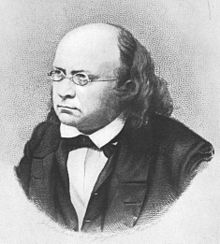Karl Friedrich Schimper
- View a machine-translated version of the German article.
- Machine translation, like DeepL or Google Translate, is a useful starting point for translations, but translators must revise errors as necessary and confirm that the translation is accurate, rather than simply copy-pasting machine-translated text into the English Wikipedia.
- Consider adding a topic to this template: there are already 9,087 articles in the main category, and specifying
|topic=will aid in categorization. - Do not translate text that appears unreliable or low-quality. If possible, verify the text with references provided in the foreign-language article.
- You must provide copyright attribution in the edit summary accompanying your translation by providing an interlanguage link to the source of your translation. A model attribution edit summary is
Content in this edit is translated from the existing German Wikipedia article at [[:de:Karl Friedrich Schimper]]; see its history for attribution. - You should also add the template
{{Translated|de|Karl Friedrich Schimper}}to the talk page. - For more guidance, see Wikipedia:Translation.
Karl Friedrich Schimper | |
|---|---|
 German naturalist and poet | |
| Born | (1803-02-15)February 15, 1803 Mannheim, Germany |
| Died | 21 December 1867 (1867-12-22) (aged 64) Schwetzingen, Germany |
| Nationality | German |
| Occupation(s) | Botanist, naturalist and poet |
Karl Friedrich Schimper (15 February 1803 – 21 December 1867) was a German botanist, naturalist and poet.
Life
Early life and education
Schimper was born in Mannheim, on February 15, 1803, to Friedrich Ludwig Heinrich Schimper and Margaretha Kathar. Jakob. Wilh. V. Furtenbach.[1] He was a theology student at Heidelberg University and taught at Munich University.
Career
Schimper pioneered research in the field of plant morphology, particularly phyllotaxis. He is perhaps best known as the originator of the theory of prehistoric hot and cold eras, and was one of the initiators of the modern theories of ice ages and climatic cycles. He was a brother of botanist Georg Wilhelm Schimper and cousin of botanist Wilhelm Philippe Schimper.
Bill Bryson states in his book A Short History of Nearly Everything that Karl Schimper originated the idea of glaciation and proposed the radical idea that ice sheets had once covered much of Europe, Asia, and North America. However, Schimper was known to be reluctant to write and never published his ideas. He discussed them with Louis Agassiz, who went on to appropriate the idea as his own and, much to Schimper's dismay, undeservedly received much of the credit for its origination.[2]
Death
Schimper died on December 21, 1867, in Schwetzingen.[1]
Works
- Beschreibung des Symphytum Zeyheri und seiner zwei deutschen verwandten der S. bulbosum Schimper und S. tuberosum Jacq : mit 6 Steintaf. . Winter, Heidelberg 1835 Digital edition by the University and State Library Düsseldorf
References
- ^ a b "Karl Friedrich SCHIMPER". GEDBAS. Retrieved 29 August 2018.
- ^ |The E.P. Evans: The Authorship of the Glacial Theory, North American review. / Volume 145, Issue 368, July 1887 Archived 2019-12-31 at the Wayback Machine. Accessed on February 25, 2008.
- ^ International Plant Names Index. K.F.Schimp.
- v
- t
- e








